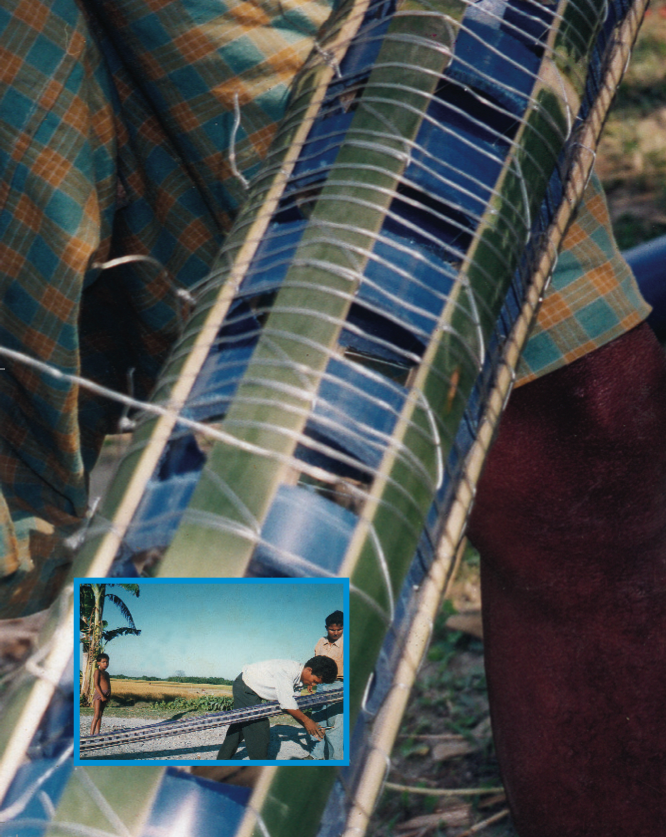Difference between revisions of "Bamboo screens"
(icon and picture) |
|||
| (25 intermediate revisions by 5 users not shown) | |||
| Line 1: | Line 1: | ||
| − | [[Image:Bamboo_screens_icon.png|right]] | + | {{Language-box|english_link= Bamboo screens | french_link= Coming soon | spanish_link= Coming soon | hindi_link= Coming soon | malayalam_link= Coming soon | tamil_link= Coming soon | korean_link= Coming soon | chinese_link=竹滤网 | indonesian_link= Coming soon | japanese_link= Coming soon }} |
| + | [[Image:Bamboo_screens_icon.png|right|80px]] | ||
| + | __NOTOC__ | ||
| + | [[Image:Bamboo_screens.PNG|thumb|right|200px|Low-cost bamboo screens that improve pumping efficiency, 4m long. Photo: NWP.]] | ||
| + | Small-scale irrigation in India usually involves the use of diesel or electric-powered suction pumps, drawing water from water tables down to 7 m deep. The India-North Bengal Terai Development Project carried out pump energy analysis, which showed that tube well screens excessively restricted water flow, resulting in low overall pumping efficiency. Improving these screens resulted in a reduction of fuel consumption of over 40%. Since publication of this innovation, thousands of wells have been fitted with the new screens, with benefits for the profitability of farming and for reducing CO2 emissions. | ||
| − | + | Bamboo screens are mainly used for irrigation purposes. | |
| − | + | ===Suitable conditions=== | |
{| border="1" cellpadding="5" cellspacing="0" align="center" | {| border="1" cellpadding="5" cellspacing="0" align="center" | ||
|- | |- | ||
! width="50%" style="background:#efefef;" | Advantages | ! width="50%" style="background:#efefef;" | Advantages | ||
| − | ! style="background:# | + | ! style="background:#f0f8ff;" | Disadvantages |
|- | |- | ||
| − | | valign="top" | | + | | valign="top" | Reduce fuel consumption of irrigation normally used for pumps.<br> |
| − | + | | valign="top" | <br> | |
| − | |||
| − | | valign="top" | | ||
|} | |} | ||
| + | ===Construction, operations and maintenance=== | ||
| − | + | 15 litres / sec (3 inch well, length of screen 4 meter). | |
| − | + | ===Costs=== | |
| − | + | New screen costs 20% of a conventional model. | |
| − | * | + | ===Manuals, videos and links=== |
| + | * [http://www.practicafoundation.nl www.practicafoundation.nl Practica Foundation] | ||
| + | * [http://www.teriin.org www.teriin.org TERI] (In 2002, TERI published a book on the subject, entitled Technology innovation and promotion in practice: pumps, channels and wells.) | ||
| − | == | + | ===Acknowledgements=== |
| − | + | * [http://www.arcworld.org/downloads/smart%20water%20solutions.pdf Smart Water Solutions: ''Examples of innovative, low-cost technologies for wells, pumps, storage, irrigation and water treatment.''] Netherlands Water Partnership (NWP). Third edition, 2006. | |
| − | |||
| − | |||
| − | |||
| − | |||
| − | |||
| − | |||
| − | |||
| − | |||
| − | |||
| − | |||
| − | |||
| − | |||
| − | |||
| − | |||
| − | |||
Latest revision as of 01:45, 10 November 2015
| |
|
|
|
|
|
|
|
|
Small-scale irrigation in India usually involves the use of diesel or electric-powered suction pumps, drawing water from water tables down to 7 m deep. The India-North Bengal Terai Development Project carried out pump energy analysis, which showed that tube well screens excessively restricted water flow, resulting in low overall pumping efficiency. Improving these screens resulted in a reduction of fuel consumption of over 40%. Since publication of this innovation, thousands of wells have been fitted with the new screens, with benefits for the profitability of farming and for reducing CO2 emissions.
Bamboo screens are mainly used for irrigation purposes.
Suitable conditions
| Advantages | Disadvantages |
|---|---|
| Reduce fuel consumption of irrigation normally used for pumps. |
|
Construction, operations and maintenance
15 litres / sec (3 inch well, length of screen 4 meter).
Costs
New screen costs 20% of a conventional model.
Manuals, videos and links
- www.practicafoundation.nl Practica Foundation
- www.teriin.org TERI (In 2002, TERI published a book on the subject, entitled Technology innovation and promotion in practice: pumps, channels and wells.)
Acknowledgements
- Smart Water Solutions: Examples of innovative, low-cost technologies for wells, pumps, storage, irrigation and water treatment. Netherlands Water Partnership (NWP). Third edition, 2006.

